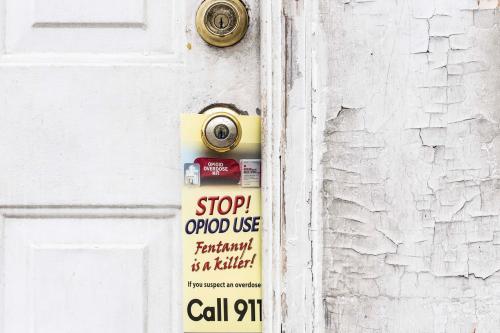This article was updated on February 13, 2019 to contextualize and clarify its discussion of harm reduction policies.
One hundred and fifteen people die each day due to an opioid overdose in the United States. Policymakers have tried many approaches to reduce this mortality rate, and researchers have been studying the effects of those policies. What have we learned so far? In this post, we examine recent research on policies aimed at reducing opioid abuse and opioid-related mortality. While the post does not, of course, summarize a comprehensive list of all the work researchers have done in this space, its aim is to highlight studies that measure the causal effect of recent policies on opioid abuse and mortality.
As an overview, the research we look at suggests that limiting the supply of opioids while maintaining access to compassionate care for those who need the medication is a challenging balance to strike. The latest empirical evidence suggests that must-access Prescription Drug Monitoring Programs (PDMPs) can help restrict opioid prescriptions, thereby reducing mortality and crime stemming from prescription opioids, but may cause some users to substitute towards illicit opioids. Additionally, policies that increase the cost of opioids may be effective, though they also make pain relief more expensive for those who need it.
Harm-reduction methods have been shown to improve some outcomes among those who are already addicted, although two recent studies suggest that they may also encourage riskier opioid use. To mitigate unintended consequences, harm-reduction policies should be paired with broad access to substance abuse treatment and alternatives to pain management, including legalized marijuana for medical use.
We describe this evidence in more detail below.
Reducing the quantity of opioids available
Many trace the current crisis to the over-prescription of opioids. With this in mind, a wave of legislation has focused on reducing opioid prescriptions by medical providers. Meara et al. (2016) considers the effects of a wide variety of state-level policies, including quantitative prescription limits, patient identification requirements, doctor-shopping restrictions, PDMPs, requirements related to tamper-resistant prescription forms, and pain-clinic regulations. The study finds no effects of any of these laws on the amount of prescription opioids received by a sample of Medicare recipients with high opioid use (fee-for-service disabled beneficiaries ages 21-64) between 2006 and 2012. These disappointing results highlight how difficult it is to change doctor and patient behavior.
But a growing literature on PDMPs finds that average effects mask important differences across state laws. PDMPs are electronic databases that track prescriptions in a state; doctors can check them to see if a particular patient has received opioids from other health providers. State laws determine whether PDMPs, when available, are voluntary or must-access—that is, whether doctors are required to check the database before writing a prescription. It appears that this detail is important.
Buchmueller and Carey (2018) use data on Medicare Part D enrollees (including elderly and disabled participants) between 2007 and 2013 to measure the effectiveness of must-access state PDMPs. They find that must-access PDMPs reduce indicators of opioid abuse while voluntary PDMPs have no effects. In particular, they find that must-access PDMPs reduce the share of enrollees obtaining a prescription from five or more different prescribers or pharmacies by 8 and 15 percent, respectively. These effects are stronger when must-access regulations are broad—that is, when doctors are required to check the database in all cases, not only when a case seems suspicious.
Similarly, Ayres and Jalal (2018) find that PDMPs are only effective in reducing prescription rates if they are must-access, and Meinhofer (2018) finds that must-access PDMPs reduce prescription opioid prescriptions and mortality. In related work, Birk and Waddell (2017) find that must-access PDMPs reduce admissions for opioid-related drug treatment (a proxy for opioid addiction), and recent work by Dave, Deza, and Horn (2018) finds that must-access PDMPs reduce a broader set of crime rates, presumably because they reduce opioid abuse (though they find the largest effects for violent crime, which is not typically associated with opioid use or markets).
In addition to PDMPs, behavioral nudges and education may also be effective strategies to reduce over-prescribing. Recent work demonstrates that changing dosage defaults in electronic medical record systems can substantially shift prescribing behavior, though default settings should be piloted to avoid choosing a dose that unintentionally leads to frequent high-dose overrides (Delgado et al., 2018). And feedback to doctors about their patients’ outcomes could also affect behavior: doctors randomly selected to receive a notification of a patient’s overdose prescribed ten percent fewer opioids in the next three months relative to a control group that did not receive such a notification (Doctor et al., 2018). Finally, large differences in prescription rates across physicians who attended different medical schools but who practice in the same specialty and clinic suggest that medical training may have a role to play in reducing over-prescribing (Schnell and Currie, 2018).
Like most policies, efforts to reduce the availability of prescription opioids will have trade-offs. When the supply of prescription opioids is reduced, those who are no longer able to access the medication may switch to heroin and illicit fentanyl. Meinhofer (2018) finds suggestive evidence that must-access PDMPs lead to increased deaths from illegal drug deaths, and Mallatt (2017) finds that PDMPs increase heroin-related arrests (a proxy for heroin use). Notably, as prescription opioids are legitimate medical products that are effective at managing pain, limiting their supply can result in increased pain and worse labor market outcomes among certain populations (Kilby, 2015; Currie, Jin, and Schnell, 2018).
Limiting the supply of opioids while maintaining access to compassionate care for those who need the medication is a challenging balance to strike.
Targeting the black market
Even if legislation manages to reduce opioid prescribing, what happens to the opioids that still make it into circulation? Powell, Pacula, and Taylor (2016) find that opioid-related mortality among younger populations increased when prescription drug benefits were expanded among the population aged 65+, suggesting that there is substantial diversion of prescription opioids for non-medical use. And Schnell (2017) finds that secondary markets for prescription opioids lead to a misallocation of the medication, which suggests that there would be substantial health gains if we could find a way to eliminate the black market for these drugs.
But it is difficult to imagine eliminating black markets in the United States—our War on Drugs has not been particularly successful at reducing illegal drug use, and policymakers are justly wary of adding another target to its list. Attempts to reduce supply can also have unintended costs. For instance, Schnell (2017) shows that physicians are more careful in their prescribing because of the potential for diversion, such that eliminating black markets would make over-prescribing even worse. And two recent papers (Evans, Lieber, and Power, 2018; Alpert, Powell, and Pacula, 2018) find that the reformulation of OxyContin (a leading prescription opioid) to make it tamper resistant—and thus more difficult to abuse—simply led those dependent on these pills to switch to heroin. The effect was zero net change in opioid-related mortality and increases in blood-borne diseases like Hepatitis B and C (Beheshti, 2018).
Harm-reduction strategies
As we look for ways to prevent opioid addiction, we would also like to help those who are already addicted to these drugs. Syringe service programs (SSPs)—a staple of harm-reduction efforts—are associated with reduced rates of HIV transmission among injectable drug users (see, e.g., Palmateer et al., 2010). The city of Vancouver, Canada, has experimented with safe injection sites to fight overdoses, particularly from heroin, and efforts to expand access to such facilities are underway in other Canadian cities and Baltimore, Maryland. While the legality of these sites, and a related harm reduction strategy of heroin-assisted treatment, is unclear under the federal Controlled Substances Act (as discussed in Beletsky et al. 2008 and Kilmer et al. 2018), the causal effects of these programs on many outcomes remains unknown.
New work by Packham (2018) suggests that SSPs unintentionally increase opioid-related mortality by making it easier, cheaper, and safer to use heroin; this is in contrast to studies in the public health literature suggesting an absence of negative consequences (WHO, 2004; IOM, 2007). As controlled trials for such programs are generally considered to be unethical, natural experiments and other quasi-experimental designs will prove useful as researchers continue to study the effects of these important programs (see Fernandes et al. 2017 for a recent systematic review; they conclude that “the scarcity and the lack of robust quality of evidence highlights the need for future community-level studies of adequate design”).
Another popular harm-reduction effort is distributing naloxone, a drug that can save someone’s life if administered during an opioid overdose. Recent work by Doleac and Mukherjee (2018) finds that broadening naloxone access had mixed results. While some states saw beneficial effects of these policy changes, broad naloxone access increased opioid-related mortality by 14 percent in the Midwest, the region hardest-hit by the opioid epidemic. (Previous work by Rees et al. (2017) did not find this effect, but their results seem to be driven by an assumption that trends from pre-epidemic years are informative about today’s experience; using their specification with more recent data points to an increase in mortality due to broad naloxone access.) The results of the Doleac and Mukherjee study suggest that broadening access to naloxone can unintentionally increase opioid abuse by reducing the cost of overdose. That is, while naloxone saves lives in the moment—which is clearly a priority for policymakers and public health officials—broad access may increase rates of drug abuse and possibly even mortality.
These findings suggest that harm-reduction policies—like policies in many contexts—involve tradeoffs. Economists have found evidence of similar unintended consequences in other public health settings, (see, e.g., Lakdawalla, Sood, and Goldman, 2006; Chan, Hamilton, and Papageorge, 2012; Buckles and Hungerman, 2018), so the idea that such tradeoffs are possible is not new or unique to opioid-related legislation.
We recognize that these findings strongly contrast with previous work by public health researchers that suggested few, if any, trade-offs that result from these harm reduction policies. Given the stakes at-hand—and the impact drug abuse can have on individuals, their families, and society at-large—this is clearly an area that needs further study. In the meantime, policymakers should acknowledge and work to mitigate any potential unintended consequences when implementing harm-reduction policies.
Increasing access to substance abuse treatment
Broader access to substance abuse treatment may help individuals manage their addiction and reduce the negative consequences of opioid use. Since treatment teaches strategies that support long-term behavioral changes, it could have larger net benefits than the harm-reduction strategies discussed above. Doleac and Mukherjee (2018) find suggestive evidence that greater access to substance abuse treatment helps mitigate the unintended negative consequences of broadening naloxone access. Swensen (2015) uses the openings and closings of drug treatment centers (including methadone clinics) as shocks to drug treatment availability and finds that a 10 percent increase in facilities per capita reduces a county’s drug-induced mortality rate by 2 percent. Using a similar strategy, Bondurant, Lindo, and Swensen (2018) find that an increase in local treatment availability reduces both violent crime and property crime. Related work by Meinhofer and Witman (2018) indicates that expanding Medicaid eligibility to low-income adults increased opioid admissions to specialty treatment facilities by 18 percent. Other work demonstrates that recent Medicaid expansions reduced crime rates; these effects appear to be driven by an increase in access to substance abuse treatment. (This suggests that crime was driven by drug use, and that substance abuse treatment reduced drug use.)
There is widespread consensus in the medical literature that medication-assisted treatments such as methadone and buprenorphine are safe and effective ways to reduce mortality among those dependent on opioids (Sordo et al., 2017). But there is not yet evidence that large-scale availability of medication-assisted treatment would mitigate the opioid mortality crisis. This is partly because federal regulations limit the widespread provision of this treatment. Providers are required to receive waivers from the Drug Enforcement Administration to offer medication-assisted treatment, and these waivers come with caps on the number of patients that an individual provider can treat. Relaxing state and federal regulatory barriers to providing medication-assisted treatment may be useful in helping more people safely manage their opioid dependence. In the interim, increasing awareness among physicians and making treatments more affordable may induce physicians to apply for waivers: for example, Stein et al. (2014) finds that statewide guidelines for prescribing office-based buprenorphine and Medicaid funding for the treatment lead to a greater supply of waived physicians. Recent work further documents that the Medicaid expansions led to market entry of medication-assisted treatment providers (Meinhofer and Witman, 2018) and increased such prescribing (Saloner et al., 2018).
Alternatives for pain management
Providing alternative sources of pain relief might also reduce the use and abuse of opioids. If a large share of opioid addiction is the result of patients becoming addicted after legitimately using prescription opioids to treat pain, then providing less risky ways to manage that pain could be helpful. Two recent studies consider whether easier access to marijuana—a potential substitute for pain relief—can reduce opioid use. Bradford, Bradford, & Abraham (2018) find that medical marijuana laws reduce prescriptions for opioids among Medicare Part D enrollees, and Powell, Pacula, & Jacobson (2018) find that medical marijuana laws reduce admissions to drug treatment and opioid-related mortality. Both studies find that ease of marijuana access matters: effects are larger in states with active marijuana dispensaries than in states that only allow home cultivation.
Reducing demand for opioids
In addition to providing patients with safer alternatives for managing pain, policymakers have searched for other ways to reduce demand for prescription opioids. If opioid use is responsive to price, then it will also be possible to reduce opioid abuse by making the drugs more expensive. Using variation in prices induced by Medicare Part D, Soni (2018) calculates a price elasticity of about -0.90 for prescription opioids, implying that a 10 percent increase in out-of-pocket price causes a 9 percent reduction in quantity demanded. Similarly, Moore and Schnepel (2018) show that a dramatic reduction in heroin availability in Australia—likely due to law enforcement intervention—increased the price of heroin and led to long-term reductions in heroin abuse.
Case and Deaton (2015, 2017) document that deaths from drug overdoses are not the only “deaths of despair” that have been rising—rather, suicides and deaths from alcoholic liver diseases and cirrhosis have also been steadily trending upwards since at least the early 2000s. While some work suggests that opioid abuse rises with unemployment (Hollingsworth, Ruhm, and Simon, 2017), other evidence suggests that temporary fluctuations in employment rates (Currie, Jin, and Schnell, 2018) and medium-run economic conditions (Ruhm, 2018) do not drive opioid abuse. More work is needed to test whether policies that improve local economic conditions could reduce opioid abuse and mortality among disadvantaged populations. Of course, policymakers have plenty of incentive already to look for ways to generate economic opportunity, and broad-based economic health as a remedy for opioid addiction may be a prescription that policymakers do not have the ability to fill.
Conclusion
Where does this tour of the evidence leave us? Unfortunately there are no clear solutions to the opioid epidemic yet, but the research described above points us in some promising directions.
This literature is developing quickly and will surely provide new insights in the months and years to come. New programs should be planned in collaboration with researchers to enable rigorous evaluation of both intended and unintended effects. This will enable us to figure out what works, and save more lives, as quickly as possible.
The authors did not receive any financial support from any firm or person for this article or from any firm or person with a financial or political interest in this article. They are currently not an officer, director, or board member of any organization with an interest in this article.
The Brookings Institution is committed to quality, independence, and impact.
We are supported by a diverse array of funders. In line with our values and policies, each Brookings publication represents the sole views of its author(s).








Commentary
Research roundup: What does the evidence say about how to fight the opioid epidemic?
December 7, 2018